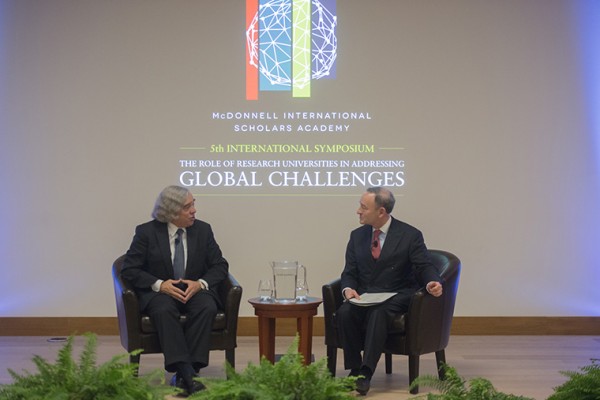Mosaic Project concludes
For the past year and a half, dedicated students, faculty and staff have come together through the university’s Mosaic Project to help move us toward a more inclusive campus community. Now, as this initiative is concluding, the efforts of the eight Mosaic Project working groups are taking root at the university.
Beautiful minds: The untold story of how Sam and Betty enriched generations of Washington University students
Known to generations of Washington University students and faculty members as “Sam and Betty,” Sam Lachterman and Betty Wynn, a homeless brother-and-sister who spent decades attending programs on campus, bequeathed $54,000 to Washington University. Half of their gift will fund the Nov. 1-2 performances of an Assembly Series event chosen just for them, “Three Acts, Two Dancers, One Radio Host” at Edison Theatre. The other half will live on in bequests to the School of Law, the Kemper Museum and Arts & Sciences.
Heart’s own immune cells can help it heal
The heart holds its own pool of immune cells capable of
helping it heal after injury, according to new research in mice at
Washington University School of Medicine in St. Louis.
Local children trick or treat on the South 40
Some 300 youngsters from across the St. Louis region were welcomed to the South 40 on the Danforth Campus of Washington University in St. Louis Oct. 25 for Safe Trick of Treat, an annual tradition.
Macones to chair committee that will design trials to study preterm birth
George Macones, MD, head of the Department of Obstetrics and Gynecology, has been named the new steering committee chair for the Maternal-Fetal Medicine Units Network (MFMU) at the Eunice Kennedy Shriver National Institute of Child Health and Human Development.
Washington University law students get firsthand experience in influential Delaware court system
To truly understand corporate law in America, the study
must go through Delaware, long the favored state of incorporations for
U.S. business. Washington University in St. Louis law students
annually get a firsthand look at how these important courts operate
through the eyes of Delaware Supreme Court and chancery judges who come
to St. Louis to deliver lectures and seminars. The students also can work in the Delaware courts through corporate judicial externships and clerkships.
The Holocaust through the eyes of Soviet-Jewish photographers
Three years before American troops liberated the Buchenwald and Dachau concentration camps, experiencing the true horror of Nazi brutality, a handful of Soviet-Jewish photographers bore witness to Nazi atrocities in their homeland. Seven decades later, historian and scholar David Shneer shares their story for the Washington University
Assembly Series and annual Holocaust Memorial Lecture, “Through Soviet Jewish Eyes: Photography, War, and the Holocaust.” The free and open event will be held at 5 p.m. Tuesday, Nov. 4 in Wilson Hall Room 214.
Genome sequenced of enterovirus D68 circulating in St. Louis
Researchers led by Gregory A. Storch, MD, at Washington University School of Medicine in St. Louis, have sequenced the genome of enterovirus D68 sampled from patients treated at St. Louis Children’s Hospital. Nationwide, the virus has spread rapidly in recent months and caused severe respiratory illness in young children, with some patients requiring hospitalization.
Addressing global challenges: The role of research universities
Representatives and leadership from Washington University and the 28 McDonnell International Scholars Academy institutions came together with policymakers, researchers, students and corporate partners for the recent Fifth International Symposium on “The Role of Research Universities in Addressing Global Challenges.” The symposium, sponsored by the McDonnell Academy, focused on how interdisciplinary research and education collaboration can lead to innovative solutions for the world’s most pressing problems
Himalayan Viagra fuels caterpillar fungus gold rush
Overwhelmed by speculators trying to cash-in on a prized medicinal fungus known as Himalayan Viagra, two isolated Tibetan communities have managed to do at the local level what world leaders often fail to do on a global scale — implement a successful system for the sustainable harvest of a precious natural resource, suggests new research from Washington University in St. Louis.
View More Stories

